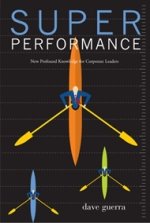It's a consistent, astonishing pattern.
Superperformng CEOs: Harley Davidson's Richard Teerlink, SYSCO's John Baugh, SW Airlines' Herb Kelleher, IBM's Tom Watson, Berkshire Hathaway's Warren Buffett, AIM's Ted Bauer, Sterling Bancshares' George Martinez and others-all of these can be described as men of uncommon humility and personal values. Most, if not all, could also be described as men of great faith. This begs a crucial question:
Is there a correlation between Servant Leadership and Superperformance?
In describing Servant Leadership, Robert Greenleaft wrote, " “The servant-leader is servant first… It begins with the natural feeling that one wants to serve, to serve first. Then conscious choice brings one to aspire to lead. He or she is sharply different from the person who is leader first, perhaps because of the need to assuage an unusual power drive or to acquire material possessions. For such it will be a later choice to serve – after leadership is established. The leader-first and the servant-first are two extreme types.” (italics added)
“The difference manifests itself in the care taken by the servant-first to make sure that other people’s highest priority needs are being served. The best test, and difficult to administer, is: do those served grow as persons; do they, while being served, become healthier, wiser, freer, more autonomous, more likely themselves to become servants? And, what is the effect on the least privileged . . .will they benefit, or, at least, will they not be further deprived?”
Is it actually possible to possible to achieve (or sustain) Superperformance without a CEO with a fundamental love for people?
Saturday, June 16, 2007
Six Sigma: So Over?
Business Week's recent article, "Six Sigma: So Yesterday?" posits the Six Sigma revolution has passed. In today's innovation economy, the article argued, blasting Six Sigma into every nook and cranny/pocket of resistance is the wrong strategy. According to Babson College management professor Tom Davenport. "Process management is a good thing. But I think it always has to be leavened a bit with a focus on innovation and [customer relationships]."
While Six Sigma (originated at Motorola) was developed as a systematic way to improve quality, the reason it caught fire has been its effectiveness in cutting costs and improving short-term profitability. But as many have observed, you cannot cost-cut your way to greatness. The chickens of "flash performance" will always come home to roost.
Six Sigma's DMAIC Model (for Define, Measure, Analyze, Improve, and Control) is an effective performance improvement model, no doubt.
So what's wrong with Six Sigma and how can it be transformed into a more robust optimization tool?
While Six Sigma (originated at Motorola) was developed as a systematic way to improve quality, the reason it caught fire has been its effectiveness in cutting costs and improving short-term profitability. But as many have observed, you cannot cost-cut your way to greatness. The chickens of "flash performance" will always come home to roost.
Six Sigma's DMAIC Model (for Define, Measure, Analyze, Improve, and Control) is an effective performance improvement model, no doubt.
So what's wrong with Six Sigma and how can it be transformed into a more robust optimization tool?
From GREAT to GOOD?
We know about companies who go from good to great, but is it possible to go in the other direction? Is it possible to have and then lose Superperformance? You betcha. The business landscape is littered with companies who were once great . . . but no more. Of the 20 companies profiled in Jim Collins' landmark Built to Last, published just 13 years ago, over half have slipped dramatically in performance and reputation, several today struggling for their corporate life. Consider the fortunes of Ford, Motorola, Sony, Boeing, Merck, or Phillip Morris, for example. According to Fast Company, "Each has struggled in recent years, and all have faced serious questions about their leadership and strategy."
What happened? How do great organizations lose their greatness? Can you chalk it all up to environmental factors outside of a company's control, or is something else at work?
What is the key to sustaining superperformance?
Surely there must be something vital to learn from the companies whose performance has yet to slide. What can we learn from Johnson & Johnson, American Express, 3M, or Wal-Mart, for example? What have these companies discovered about greatness that is still operating today?
Or it going from super to "stupor" inevitable for all?
What happened? How do great organizations lose their greatness? Can you chalk it all up to environmental factors outside of a company's control, or is something else at work?
What is the key to sustaining superperformance?
Surely there must be something vital to learn from the companies whose performance has yet to slide. What can we learn from Johnson & Johnson, American Express, 3M, or Wal-Mart, for example? What have these companies discovered about greatness that is still operating today?
Or it going from super to "stupor" inevitable for all?
Subscribe to:
Comments (Atom)




